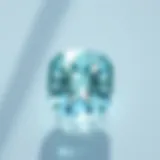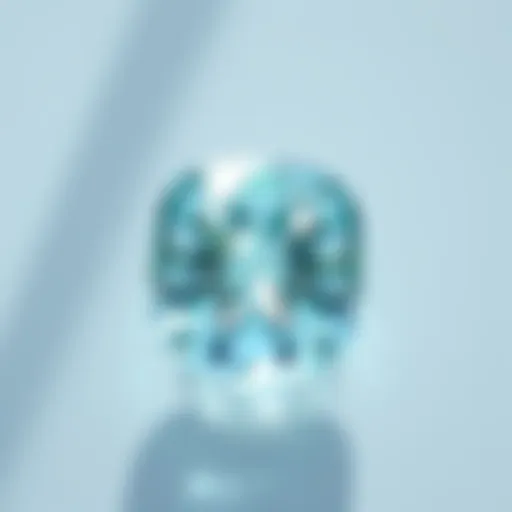Are Lab-Created Diamonds the Right Choice for You?
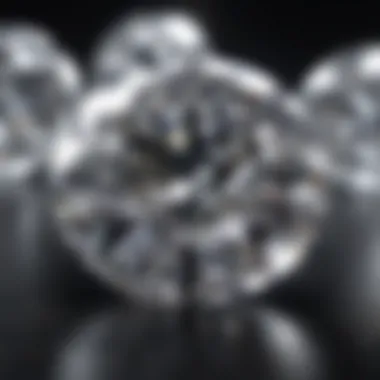

Intro
Lab-created diamonds are becoming a popular option for those seeking an alternative to natural diamonds. These gems provide unique benefits that appeal to various consumers, including considerations of ethics, cost, and availability. This article delves into what makes lab-created diamonds distinct and evaluates whether they suit your needs.
Gemstone Overview
Definition of Gemstones
Gemstones are precious or semi-precious stones that are valued for their beauty and rarity. They can be used in jewelry or for decorative purposes. Among these stones, diamonds are particularly celebrated for their clarity, brilliance, and durability. Understanding the differences between lab-created and natural diamonds begins with this foundation of what gemstones represent.
Classification of Gemstones
Gemstones can be classified in several ways:
- Natural: Derived from geological processes over millions of years.
- Synthetic: Lab-created to replicate natural stones, such as diamonds.
- Composite: Made from multiple materials joined together.
This classification helps understand where lab-created diamonds fit within the larger spectrum of gemstones.
Historical Significance
Origins of Gemstone Use
The use of gemstones can be traced back to ancient civilizations. Cultures often revered these stones for their supposed magical and protective properties. Diamonds were considered symbols of wealth and strength, cultivated in the earth over extensive periods. However, with the advent of technology, the narrative changed.
Cultural Insights: Gemstones in Ancient Civilizations
In many ancient civilizations, like those of Egypt and Mesopotamia, gemstones carried significant cultural weight. They were often used in adornment and burial customs. This historical context provides a profound understanding of why gemstones, and specifically diamonds, have retained their allure throughout time. By appreciating this significance, one can better understand the transition towards lab-created alternatives.
"Lab-created diamonds offer the beauty of natural diamonds without the associated ethical concerns."
As consumers become increasingly aware of the implications of their purchases, the exploration of lab-created diamonds highlights a vital conversation in the jewelry market. This examination promises readers clarity in a market characterized by tradition and modernity.
Intro to Lab-Created Diamonds
Lab-created diamonds have risen to prominence in the jewelry market as a viable alternative to natural diamonds. A crucial understanding of this topic opens up discussions about ethics, sustainability, and value in gemstone purchasing. This section will focus on defining what lab-created diamonds are and exploring their historical context. The importance of knowing these aspects cannot be overstated, as it lays the groundwork for informed choices in an evolving market.
Defining Lab-Created Diamonds
Lab-created diamonds, also referred to as synthetic diamonds or cultured diamonds, are gemstones produced in controlled settings using advanced technology. Unlike their natural counterparts extracted from the earth, these diamonds undergo processes that simulate the natural conditions under which diamonds develop over millions of years. The result is a diamond that is optically, chemically, and physically indistinguishable from a mined diamond.
These diamonds are produced primarily through two methods: High Pressure High Temperature (HPHT) and Chemical Vapor Deposition (CVD). Both processes create diamonds that possess the same brilliance and durability as natural diamonds, often at a more accessible price point.
Historical Context
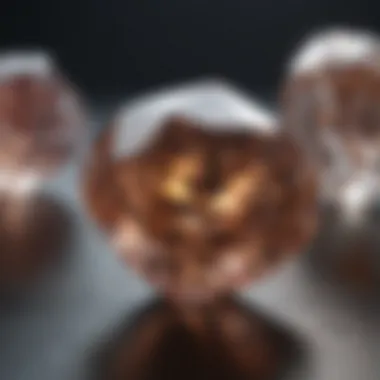

The development of lab-created diamonds traces back to the mid-20th century, marking a significant technological breakthrough in gemstone production. The first successful creation occurred in 1954 with the HPHT method. Initially, lab diamonds were mainly used for industrial purposes, including cutting and drilling.
However, as technology advanced, the aesthetic qualities of lab-created diamonds improved significantly, leading to a shift in consumer interest. The commercial availability of these diamonds started to rise around the early 2000s, coinciding with growing awareness of ethical concerns surrounding the natural diamond mining industry, such as environmental degradation and human rights issues.
Today, lab-created diamonds are not just accepted but embraced in the jewelry market. The historical trajectory underscores a growing recognition that consumers can choose beautiful gemstones without compromising their ethical beliefs or financial constraints. This evolution reflects a broader trend toward sustainability in consumer behavior.
The Creation Process
Understanding the creation process of lab-created diamonds is essential for anyone considering these gems as an alternative to natural diamonds. The methods involved not only define the characteristics of the stones but also reflect the technology and ethical implications tied to their production. Knowing how these diamonds come to life helps consumers make educated choices, weighing their preferences against personal values and economic factors.
High Pressure High Temperature (HPHT)
High Pressure High Temperature (HPHT) is one of the primary methods used to create lab diamonds. Inspired by the natural processes that form diamonds in the Earth’s mantle, this technique simulates those extreme conditions within a laboratory setting. HPHT consists of placing carbon sources under intense pressure and heat, replicating the environment found in geological formations.
The process begins with a small diamond seed, which acts as a catalyst for further growth. As temperature exceeds 1,300 degrees Celsius and pressure rises up to 1.5 million pounds per square inch, carbon atoms start to crystallize around the seed. This results in the formation of a diamond over days or weeks, depending on the specific conditions.
Benefits of HPHT include:
- Quality and Clarity: Often, HPHT diamonds have fewer inclusions compared to those created using other methods.
- Color and Certification: Many HPHT diamonds achieve desirable colors and can be certified by reputable grading entities.
- Speed of Production: This method also allows for faster production cycles, catering to the growing demand for lab-created diamonds.
However, considerations such as the energy consumption required for both the press and the heating elements play a role in the sustainability evaluation of this process.
Chemical Vapor Deposition ()
Another prominent method for diamond creation is Chemical Vapor Deposition (CVD). This technique involves breaking down carbon-rich gases and allowing the carbon atoms to deposit on a diamond seed, gradually building up a diamond structure layer by layer. CVD is regarded as a more precise method, enabling the control of diamond quality and characteristics.
In the CVD chamber, gases such as methane and hydrogen are introduced under specific temperatures and pressures. The process requires careful regulation of these variables to create optimal conditions for diamond growth. Unlike HPHT, where high temperatures and pressures are immediate, CVD can be seen as a more gradual buildup, generally taking several weeks to produce a gem-grade diamond.
Key advantages of CVD diamonds include:
- Controlled Growth: This method offers flexibility regarding the size and purity of diamonds, which can lead to unique and specific customer preferences.
- Cost-Effectiveness: CVD diamonds may provide a more affordable option without compromising on quality, aligning well with budget-conscious consumers.
- Environmental Impact: Although energy-intensive, CVD processes can be streamlined to reduce waste and environmental footprint.
Comparison with Natural Diamonds
The comparison between lab-created diamonds and natural diamonds is a critical aspect of this discussion, serving to elucidate the unique characteristics and implications of each type. Understanding these differences can assist consumers in making informed decisions about their gemstone purchases. Notably, factors such as physical characteristics, chemical composition, and price point play a significant role in this comparison. These elements contribute to the overall consumer experience and satisfaction when choosing between the two types of diamonds.
Physical Characteristics
Clarity
Clarity is one of the most significant factors when evaluating diamonds. It refers to the presence of internal or external flaws, known as inclusions and blemishes, respectively. Lab-created diamonds typically exhibit higher clarity than many natural counterparts. The rigorous processes used in labs often ensure that fewer imperfections are present, making a lab-created diamond aesthetically appealing. The key characteristic of clarity in lab-created diamonds is that it helps in achieving a higher quality appearance, which is desirable for consumers. The unique feature of clarity becomes advantageous as it allows for a more brilliant and sparkling gem. Moreover, this clarity equates to a better perception of value by collectors and jewelry designers who prioritize perfection in their gemstones.
Color
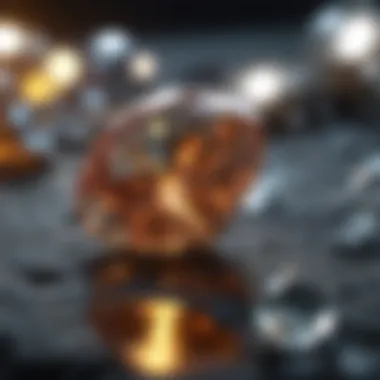

The color of a diamond is another pivotal aspect that influences its desirability and market value. Lab-created diamonds can be produced in a variety of colors, including colorless and fancy colors, through controlled processes. The key characteristic of color here lies in lab-created diamonds’ ability to achieve and maintain consistent shades across the spectrum. This is beneficial for those seeking specific hues, as it expands options significantly. However, the unique feature of lab-created diamonds is that their color can vary based on production techniques, which may lead to occasional inconsistencies. Therefore, understanding color variation and its interpretation in the market becomes crucial for buyers.
Cut
Cut is fundamental to how a diamond reflects light and ultimately influences its overall beauty. The term "cut" refers not only to the shape of the diamond but also to the quality of the craftsmanship involved in the shaping of the stone. Lab-created diamonds can be cut to high precision, often surpassing that of many natural diamonds. The key characteristic of cut is that it dramatically alters the appearance and brilliance of the diamond, affecting its visual appeal. This means that lab-created diamonds, when cut well, are immensely popular choices for consumers. The unique feature associated with lab-created diamond cut is that bespoke cutting services are more accessible, allowing buyers to obtain custom cuts suited to their tastes. However, this trend forces consumers to remain vigilant about ensuring they are partnering with skilled artisans for their cuts.
Chemical Composition
The chemical composition of lab-created diamonds is identical to that of natural diamonds, both being pure carbon in a crystal lattice structure. This ensures that lab-created diamonds possess similar physical properties, including hardness and durability. Therefore, chemically, consumers can rest assured they are purchasing a product equivalent to natural diamonds. Understanding this facet is important as it dismantles any preconceived notions about the inferiority of lab-created diamonds.
Price Point
Price is a critical consideration when evaluating lab-created versus natural diamonds. Typically, lab-created diamonds are priced lower due to reduced overhead costs in production. The price point can vary significantly based on specific qualities such as size, clarity, cut, and color, but generally, consumers find more value for their money in lab-created options. This financial advantage makes lab-created diamonds attractive for those who desire ethical choices without compromising on quality. As budget-friendly alternatives, they meet the needs of a diverse range of consumers, including jewelry designers and collectors.
The importance of assessing these specific elements—clarity, color, cut, chemical composition, and price point—cannot be underestimated. These are essential criteria that influence both the consumer's decision-making process and the broader implications of gemstone choices.
Ethical Considerations
Understanding the ethical implications of lab-created diamonds holds paramount importance for today's consumers. As the discourse around sustainability and ethics grows, many individuals are seeking alternatives to traditional gemstones. Lab-created diamonds provide an appealing option, blending aesthetic appeal with a commitment to ethical practices.
Conflict-Free Assurance
A major point of consideration when choosing between lab-created and natural diamonds is the concept of conflict-free assurance. Natural diamonds have often been linked to human rights violations, particularly in conflict zones where they are mined. These so-called "blood diamonds" raise significant ethical concerns for consumers, sparking a desire for more transparent and responsible sourcing.
In contrast, lab-created diamonds are manufactured in controlled environments, completely circumventing the issues tied to diamond mining. Each gem comes with an assurance that its origins are free from conflict, providing consumers peace of mind when making a purchase. This conflict-free guarantee does not merely alleviate guilt; it becomes a significant selling point in the increasingly ethical fashion market.
Sustainability Impact
Another critical aspect of lab-created diamonds is their sustainability impact. The extraction of natural diamonds typically involves extensive mining operations, which can lead to environmental degradation. Ecosystems can be disrupted, and significant amounts of land and water resources are often affected. Moreover, mining activities contribute to greenhouse gas emissions, further stressing the environment.
Lab-created diamonds, on the other hand, offer a more sustainable choice. The resources required for their production are significantly lower in terms of land use and environmental disruption. Furthermore, the energy needed to create lab diamonds is often sourced from renewable energy systems, reducing their overall carbon footprint. This commitment to sustainability not only benefits the environment but also aligns with the values of consumers who prioritize eco-friendly practices.
"Choosing lab-created diamonds reflects a growing trend toward conscious consumerism, where purchasing decisions reflect personal values, especially regarding ethical implications and environmental responsibility."
In summary, consumers navigating the jewelry market can consider lab-created diamonds as a viable option. With conflict-free assurance and a reduced sustainability impact, these crafted gems offer an ethical alternative without sacrificing beauty or quality.
Consumer Preferences
When considering lab-created diamonds, consumer preferences play a crucial role. Understanding what people want and need guides their choices in the jewelry market. This section dissects key elements that influence these preferences. It shows how market trends and changing attitudes shape preferences towards these gems.
Market Trends
The landscape of the jewelry industry has experienced significant shifts in recent years. Increasing demand for ethical and sustainable products drives a growing market for lab-created diamonds. Many consumers are now prioritizing these aspects over traditional luxury markers.
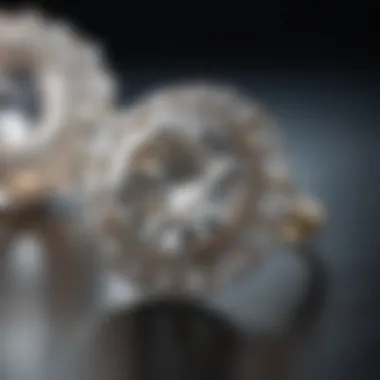

- Ethical Production: Today's buyers often seek products that are conflict-free. Lab-created diamonds offer assurance that no human rights abuses are involved in their production. This is increasingly seen as a significant factor when making purchases.
- Pricing Consideration: Lab-created diamonds are usually more affordable than their natural counterparts. The price difference often attracts cost-sensitive buyers, making these gems an attractive option.
- Technological Advancements: The way diamonds are produced has advanced, making lab-created gems more appealing in terms of quality and appearance. Consumers can now get similar quality for lesser prices.
According to recent studies, more millennials and Gen Z consumers are gravitating towards lab-created diamonds. They appreciate their ethical impact and affordability.
Changing Attitudes
Consumer attitudes are evolving, particularly regarding luxury and tradition. Today's consumers are less inclined to follow traditional norms in jewelry purchases. This shift results from several factors:
- Awareness: With growing awareness of the environmental and social implications of mining, buyers are more informed. This knowledge encourages many to choose lab-created diamonds instead.
- Cultural Influences: The stigma that may have once been attached to lab-created diamonds is diminishing. Celebrities and influencers often showcase these gems, demonstrating their beauty and quality, which attracts more attention and acceptance.
- Personalization: Many consumers prefer products that reflect their values. Lab-created diamonds can cater to personalized tastes without compromising on ethics. This aligns with a culture increasingly valuing individuality over conformity.
The shift we are witnessing in consumer preferences underscores a broader movement towards responsible purchasing habits in jewelry.
As insights into consumer preferences show, lab-created diamonds could cater effectively to the modern buyer. A consideration of ethical, economic, and cultural factors has shifted preferences towards these contemporary gems. Understanding this landscape helps consumers make more informed choices.
Potential Drawbacks
Lab-created diamonds are gaining traction in the jewelry market, yet it is essential to examine the potential drawbacks. Understanding these aspects can help consumers make a more informed decision. While these diamonds present significant advantages, a few limitations warrant thoughtful consideration.
Perceived Value
The perception of value plays a crucial role in the choice between lab-created and natural diamonds. Many consumers equate natural diamonds with sentimental value, exclusivity, and a sense of tradition. To some, lab-created diamonds may seem less desirable, simply because they are not formed through geological processes. This sentiment can be driven by deeply rooted beliefs about what constitutes a valuable gemstone.
Moreover, social factors influence perceptions. Wearing a natural diamond can be seen as a status symbol, whereas lab-created diamonds may not carry the same weight in traditional or luxury settings. As a result, some individuals may view them as less prestigious. This perception could impact personal satisfaction in ownership and gifting, particularly in cultures where natural diamonds hold significant ceremonial and cultural importance.
Resale Value
Resale value is another significant drawback associated with lab-created diamonds. When it comes to re-selling a diamond, natural gemstones often hold their value or appreciate over time. In contrast, lab-created diamonds typically depreciate after purchase. The market for re-selling lab-created diamonds is still developing, leading to uncertain returns for sellers. Consumers may find it challenging to recoup their initial investment, depending on market demand and consumer sentiment.
Additionally, the rarity of natural diamonds adds to their allure, whereas lab-created diamonds are more abundant. This abundance can make lab-created diamonds less appealing in the resale market. Although buyers may find them more affordable up front, the long-term worth remains questionable.
"Lab-created diamonds provide an ethical and affordable option, but understanding their drawbacks is vital for potential buyers."
Overall, while lab-created diamonds carry ethical, environmental, and financial benefits, it is essential to weigh these against the perceived value and potential depreciation in the secondary market. Awareness of these factors can guide consumers in making decisions that align with their values and expectations.
Closure
The examination of lab-created diamonds in this article highlights several critical points that encourage cautious but informed decisions for potential buyers. Lab-created diamonds represent a thoughtful alternative to their natural counterparts, not just in price but also in ethical considerations. This evolving landscape forces consumers to weigh their choices based on personal values, financial situations, and aesthetic preferences.
Making an Informed Decision
When it comes to purchasing diamonds, it is essential to understand all aspects surrounding the choice between lab-created and natural diamonds. Consumers can begin by assessing their values—namely, the importance of ethical sourcing, sustainability, and costs. Lab-created diamonds offer a conflict-free guarantee, thus appealing to environmentally-conscious buyers.
In terms of budget, lab-created diamonds often provide substantial savings compared to natural diamonds. Therefore, it is advisable for consumers to compare options, looking closely not only at prices but at quality and characteristics to ensure that they get the best possible deal, regardless of the type they choose. Furthermore, engaging with trusted jewelers and exploring customer reviews can also add depth to their research.
Future of Lab-Created Diamonds
The trajectory of the lab-created diamond market shows promising signs of growth and acceptance. Major retailers are beginning to expand their offerings, leading to more variety and competitive prices. Additionally, as awareness of sustainable practices increases, so does the interest in lab-created gems.
Innovation plays a significant role in this evolution. Techniques like High Pressure High Temperature (HPHT) and Chemical Vapor Deposition (CVD) continue to improve, making lab-created diamonds even more comparable to natural ones.
As manufacturing processes become more efficient, we can expect increased production and better pricing strategies, which will only benefit consumers. Overall, the future points towards a wider acceptance of lab-created diamonds, which may not only coexist with natural diamonds but also compete directly with them in terms of desirability and status in the market.
